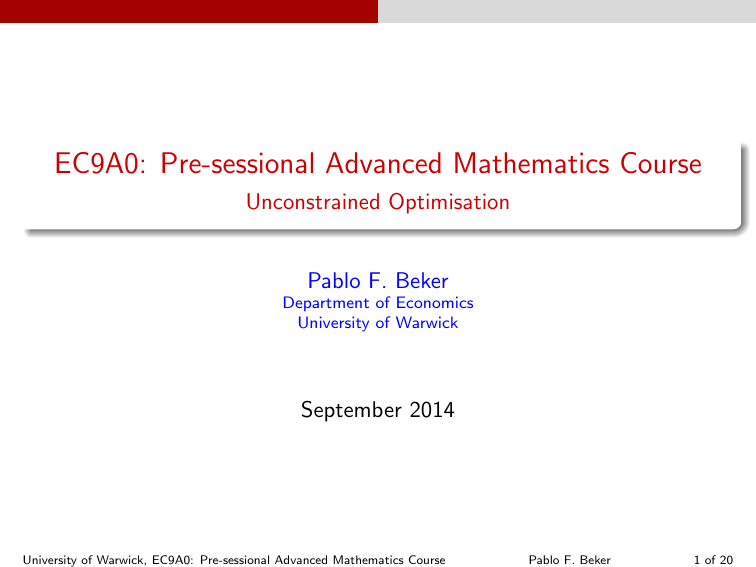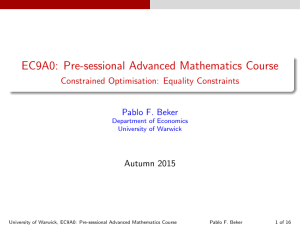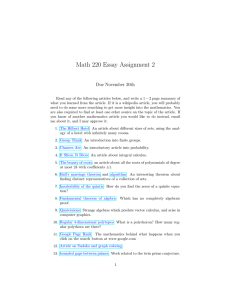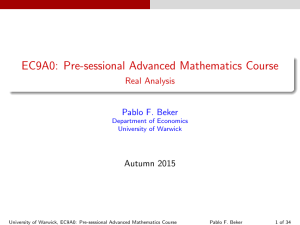EC9A0: Pre-sessional Advanced Mathematics Course Unconstrained Optimisation Pablo F. Beker September 2014
advertisement

EC9A0: Pre-sessional Advanced Mathematics Course
Unconstrained Optimisation
Pablo F. Beker
Department of Economics
University of Warwick
September 2014
University of Warwick, EC9A0: Pre-sessional Advanced Mathematics Course
Pablo F. Beker
1 of 20
Lecture Outline
1
2
3
4
5
Infimum and Supremum
Definitions
Properties
Maximisers
Definitions
Existence
Local Maxima
Necessary Conditions in R
Sufficient Conditions in R
Necessary Conditions in RK
Sufficient Conditions in RK
When is a Local max also a Global Max?
Functions in R with only one critical point
Concavity and Quasi-Concavity
Uniqueness
University of Warwick, EC9A0: Pre-sessional Advanced Mathematics Course
Pablo F. Beker
2 of 20
Infimum and Supremum
Definitions
Infimum and Supremum: Definitions
Definition
Fix a set Y ⊆ R. A number α ∈ R is an upper bound of Y if y ≤ α for all
y ∈ Y , and is a lower bound of Y if the opposite inequality holds.
Definition
α ∈ R is the least upper bound of Y , denoted α = sup Y , if:
1
α is an upper bound of Y ; and
2
γ ≥ α for any other upper bound γ of Y .
Definition
β ∈ R is the greatest lower bound of Y , denoted β = inf Y , if:
1
β is a lower bound of Y ; and
2
if γ is a lower bound of Y , then γ ≤ β.
University of Warwick, EC9A0: Pre-sessional Advanced Mathematics Course
Pablo F. Beker
3 of 20
Infimum and Supremum
Properties
Properties of Infimum and Supremum
Theorem 1
α = sup Y if and only if for every ε > 0,
(a) y < α + ε for all y ∈ Y ; and
(b) there is some y ∈ Y such that α − ε < y .
Corollary 1
Let Y ⊆ R and let α ≡ sup Y . Then there exists a sequence {yn }n∞=1 in
Y that converges to α.
We need a stronger concept of extremum, in particular one that implies
that the extremum lies within the set.
University of Warwick, EC9A0: Pre-sessional Advanced Mathematics Course
Pablo F. Beker
4 of 20
Maximisers
Definitions
Maximisers
Definition
A point x ∈ R is the maximum of set Y ⊆ R, denoted x = max A, if
x ∈ Y and y ≤ x for all y ∈ Y .
Typically, it is of more interest in economics to find extrema of
functions, rather than extrema of sets
Definition
x̄ ∈ D is a global maximizer of f : D → R if f (x ) ≤ f (x̄ ) for all x ∈ D.
Definition
x̄ ∈ D is a local maximizer of f : D → R if there exists some ε > 0 such
that f (x ) ≤ f (x̄ ) for all x ∈ Bε (x̄ ) ∩ D.
When x̄ ∈ D is a local (global) maximizer of f : D → R, the number
f (x̄ ) is said to be a local (the global) maximum of f .
University of Warwick, EC9A0: Pre-sessional Advanced Mathematics Course
Pablo F. Beker
5 of 20
Maximisers
Existence
Existence
Theorem (Weierstrass)
Let C ⊆ D be nonempty and compact. If f : D → R is continuous, then
there are x̄, x ∈ C such that f (x ) ≤ f (x ) ≤ f (x̄ ) for all x ∈ C .
Proof: It follows from 5 steps:
1
Since C is compact and f is continuous, then f [C ] is compact.
2
By Corollary 1, there is {yn }n∞=1 in f [C ] s.t. yn → sup f [C ].
3
Since f [C ] is compact, then it is closed. Therefore, sup f [C ] ∈ f [C ].
4
Thus, there is x ∈ C such that f (x ) = sup f [C ].
5
By def. of sup, f (x ) ≥ f (x ) for all x ∈ C .
Q.E.D.
University of Warwick, EC9A0: Pre-sessional Advanced Mathematics Course
Pablo F. Beker
6 of 20
Local Maxima
Necessary Conditions in R
Characterising Maximisers in R
Lemma 1
Suppose D ⊂ R is open and f : D → R is differentiable. Let x̄ ∈ int (D ).
If f 0 (x̄ ) > 0, then there is some δ > 0 such that for each x ∈ Bδ (x̄ ) ∩ D:
1 f (x ) > f (x̄ ) if x > x̄.
2
f (x ) < f (x̄ ) if x < x̄.
Proof: ε ≡
f 0 (x̄ )
2
> 0. Then, f 0 (x̄ ) − ε > 0 . By def. of f 0 , ∃δ > 0 s.t.,
f (x̄ )
| f (xx)−
− f 0 (x̄ )| < ε, ∀x ∈ Bδ0 (x̄ ) ∩ D.
−x̄
Hence,
f (x )−f (x̄ )
x −x̄
> f 0 (x̄ ) − ε > 0.
Q.E.D.
Corollary 2
Suppose D ⊂ R is open and f : D → R is differentiable. Let x̄ ∈ D. If
f 0 (x̄ ) < 0, then there is δ > 0 such that for every x ∈ Bδ (x̄ ) ∩ D:
1
f (x ) < f (x̄ ) if x > x̄.
2
f (x ) > f (x̄ ) if x < x̄.
University of Warwick, EC9A0: Pre-sessional Advanced Mathematics Course
Pablo F. Beker
7 of 20
Local Maxima
Necessary Conditions in R
Characterising Maximisers in R: FO Necessary Conditions
Theorem (FONC)
Suppose that f : D → R is differentiable. If x̄ ∈ int(D ) is a local
maximiser of f then f 0 (x̄ ) = 0.
Proof: Suppose f 0 (x̄ ) 6= 0. WLOG, suppose f 0 (x̄ ) > 0.
1 By Lemma 1, ∃ δ > 0 such that f (x ) > f (x̄ ) for all x ∈ B (x̄ ) ∩ D
δ
satisfying x > x̄.
2 Since x̄ is a local maximizer of f , ∃ ε > 0 such that f (x ) ≤ f (x̄ ) for
all x ∈ Bε (x̄ ) ∩ D.
3 Since x̄ ∈ int(D ), ∃ γ > 0 such that B (x̄ ) ⊆ D.
γ
4 Let β = min{ ε, δ, γ } > 0.
5 Clearly, (x̄, x̄ + β ) ⊂ B 0 (x̄ ) ⊆ D. Moreover, B 0 (x̄ ) ⊆ B (x̄ ) ∩ D and
δ
β
β
Bβ0 (x̄ ) ⊆ Bε (x̄ ) ∩ D.
6 ∃x such that f (x ) > f (x̄ ) and f (x ) ≤ f (x̄ ), a contradiction.
Q.E.D.
University of Warwick, EC9A0: Pre-sessional Advanced Mathematics Course
Pablo F. Beker
8 of 20
Local Maxima
Necessary Conditions in R
Characterising Maximisers in R: SO Necessary Conditions
Theorem (SONC)
Let f : D → R be C2 . If x̄ ∈ int(D ) is a local max of f , then f 00 (x̄ ) ≤ 0.
Proof: Since x̄ ∈ int(D ), there is a ε > 0 such that Bε (x̄ ) ⊆ D.
1 Let h ∈ B (0). Since f is C2 , Taylor’s Theorem implies ∃x ∗ ∈ [x̄,
ε
h
x̄ + h] such that
1
f (x̄ + h ) = f (x̄ ) + f 0 (x̄ )h + f 00 (xh∗ )h2
2
2 ∃ δ > 0 such that f (x ) ≤ f (x̄ ) for all x ∈ B (x̄ ) ∩ D.
δ
3 Let β = min{ ε, δ } > 0. By construction, for any h ∈ B 0 (0)
β
1
f 0 (x̄ )h + f 00 (xh∗ )h2 = f (x̄ + h ) − f (x̄ ) ≤ 0.
2
4 By Theorem FONC, f 0 (x̄ ) = 0 and so f 0 (x̄ )h = 0.
5 Hence, f 00 (x ∗ )h 2 ≤ 0 =⇒ f 00 (x ∗ ) ≤ 0.
h
h
00 ∗
00
00
6 lim
h→0 f (xh ) ≤ 0, and hence that f (x̄ ) ≤ 0, since f is continuous
and each xh lies in the interval joining x̄ and x̄ + h.
Q.E.D.
University of Warwick, EC9A0: Pre-sessional Advanced Mathematics Course
Pablo F. Beker
9 of 20
Local Maxima
Sufficient Conditions in R
Characterising Maximisers in R: Sufficient Conditions
Theorem (FOSC & SOSC)
Suppose that f : D → R is C2 . Let x̄ ∈ int(D ). If f 0 (x̄ ) = 0 and
f 00 (x̄ ) < 0, then x̄ is a local maximizer.
Proof: Since f : D → R is C2 & f 00 (x̄ ) < 0, by Corollary 2 ∃δ > 0 s.t.
(a)f 0 (x ) < f 0 (x̄ ) = 0, for all x ∈ Bδ (x̄ ) ∩ D for which x > x̄; and
(b)f 0 (x ) > f 0 (x̄ ) = 0, for all x ∈ Bδ (x̄ ) ∩ D for which x < x̄.
1 Since x ∈ int(D ), there is ε > 0 such that B (x̄ ) ⊆ D.
ε
2 Let β = min{ δ, ε } > 0. By the MV Theorem, ∃x ∗ ∈ [x̄, x ] s.t.
f (x ) = f (x̄ ) + f 0 (x ∗ )(x − x̄ ) for all x ∈ Bβ (x̄ )
3
4
x > x̄ ⇒ x ∗ ≥ x̄. Hence, (a) ⇒ f 0 (x ∗ )(x − x̄ ) ≤ 0 ⇒ f (x ) ≤ f (x̄ ).
x < x̄ ⇒ x ∗ ≤ x̄. Hence, (b) ⇒ f 0 (x ∗ )(x − x̄ ) ≥ 0 ⇒ f (x ) ≤ f (x̄ ).
Q.E.D.
00
0
∗
00
We use f (x ) < 0 to show f (x )(x − x̄ ) ≤ 0. Why f (x ) ≤ 0 is not
enough?
University of Warwick, EC9A0: Pre-sessional Advanced Mathematics Course
Pablo F. Beker
10 of 20
Local Maxima
Sufficient Conditions in R
Example in R
Consider f (x ) = x 4 − 4x 3 + 4x 2 + 4.
Note that
f 0 (x ) = 4x 3 − 12x 2 + 8x = 4x (x − 1)(x − 2).
Hence, f 0 (x ) = 0 ⇐⇒ x ∈ {0, 1, 2}.
Since f 00 (x ) = 12x 2 − 24x + 8,
f 00 (0) = 8 > 0, f 00 (1) = −4 < 0, and f 00 (2) = 8 > 0
x = 0 and x = 2 are local min of f and x = 1 is a local max.
x = 0 and x = 2 are global min but x = 1 is not a global max.
University of Warwick, EC9A0: Pre-sessional Advanced Mathematics Course
Pablo F. Beker
11 of 20
Local Maxima
Necessary Conditions in RK
Characterising Maximisers in RK : Necessary Conditions
Suppose D ⊂ RK
Theorem
If f : D → R is differentiable and x ∗ ∈ int(D ) is a local maximizer of f ,
then Df (x ∗ ) = 0.
Theorem
If f : D → R is C2 and x ∗ ∈ int(D ) is a local maximizer of f , then
D 2 f (x ∗ ) is negative semidefinite.
University of Warwick, EC9A0: Pre-sessional Advanced Mathematics Course
Pablo F. Beker
12 of 20
Local Maxima
Sufficient Conditions in RK
Characterising Maximisers in RK : Sufficient Conditions
Suppose D ⊂ RK
Theorem
Suppose that f : D → R is C2 and let x̄ ∈ int(D ). If Df (x̄ ) = 0 and
D 2 f (x̄ ) is negative definite, then x̄ is a local maximizer.
University of Warwick, EC9A0: Pre-sessional Advanced Mathematics Course
Pablo F. Beker
13 of 20
Local Maxima
Sufficient Conditions in RK
Example in R2
Consider f (x, y ) = x 3 − y 3 + 9xy .
Note that
fx0 (x, y ) = 3x 2 + 9y
fy0 (x, y ) = −3y 2 + 9x
Hence,
fx0 (x, y ) = 0 and fy0 (x, y ) = 0 ⇐⇒ (x, y ) ∈ {(0, 0), (3, −3)}.
00
fxx fyx00
6x
9
2
D f (x ) =
=
.
fxy00 fyy00
9 −6y
fxx00 = 6x and |D 2 f (x, y )| = −36xy − 81.
At (0, 0) the two minors are 0 and −81. Hence, D 2 f (0, 0) is indef.
At (3, −3) the two minors are 18 and 243. Hence, D 2 f (3, −3) is
positive definite and (3, −3) is a local min.
(3, −3) is not a global min since f (0, n) = −n3 → −∞ as n → ∞.
University of Warwick, EC9A0: Pre-sessional Advanced Mathematics Course
Pablo F. Beker
14 of 20
When is a Local max also a Global Max?
Functions in R with only one critical point
Functions in R with only one critical point
Suppose D ⊂ R
Theorem
Suppose that f : D → R is C1 in the interior of D and:
1
the domain of f is an interval in R.
2
x is a local maximum of f , and
3
x is the only solution to f 0 (x ) = 0 on D.
Then, x is the global maximum of f .
University of Warwick, EC9A0: Pre-sessional Advanced Mathematics Course
Pablo F. Beker
15 of 20
When is a Local max also a Global Max?
Concavity and Quasi-Concavity
Concavity and Quasi-Concavity: Definitions
Definition
Let D be a convex subset of RK . Then, f : D → R is
concave if for all x, y ∈ D, and for all θ ∈ [0, 1],
f (θx + (1 − θ )y ) ≥ θf (x ) + (1 − θ )f (y )
strictly concave if for all x, y ∈ D, x 6= y , and for all θ ∈ (0, 1),
f (θx + (1 − θ )y ) > θf (x ) + (1 − θ )f (y )
quasi-concave if for all x, y ∈ D, and for all θ ∈ [0, 1],
f (x ) ≥ f (y ) =⇒ f (θx + (1 − θ )y ) ≥ f (y )
strictly quasi-concave if for all x, y ∈ D, x 6= y , and for all θ ∈ (0, 1),
f (x ) ≥ f (y ) =⇒ f (θx + (1 − θ )y ) > f (y )
University of Warwick, EC9A0: Pre-sessional Advanced Mathematics Course
Pablo F. Beker
16 of 20
When is a Local max also a Global Max?
Concavity and Quasi-Concavity
Ordinal Properties
Theorem
Suppose f : D → R is quasi-concave and g : f (D ) → R is nondecreasing.
Then g ◦ f : X → R is quasi-concave. If f is strictly quasi-concave and g
is strictly increasing, then g ◦ f is strictly quasi-concave.
Proof: Since f is quasi-concave, f (θx + (1 − θ )y ) ≥ min{f (x ), f (y )}.
Since g is nondecreasing,
g (f (θx + (1 − θ )y )) ≥ g (min{f (x ), f (y )}) = min{g (f (x )), g (f (y ))}.
If f is strictly quasi-concave, x 6= y , f (θx + (1 − θ )y ) > min{f (x ), f (y )}.
Since g is strictly increasing,
g (f (θx + (1 − θ )y )) > g (min{f (x ), f (y )}) = min{g (f (x )), g (f (y ))}.
Q.E.D.
University of Warwick, EC9A0: Pre-sessional Advanced Mathematics Course
Pablo F. Beker
17 of 20
When is a Local max also a Global Max?
Concavity and Quasi-Concavity
When is a Local Max also a Global Max? - Concavity
Theorem
Suppose that D ⊂ RK is convex and f : D → R is a concave function. If
x̄ ∈ D is a local maximizer of f , then it is also a global maximizer.
Proof: Suppose that x̄ ∈ D is a local but not a global maximizer of f .
∃ε > 0 such that f (x ) ≤ f (x̄ ) for all x ∈ Bε (x̄ ) ∩ D and
∃x ∗ ∈ D such that f (x ∗ ) > f (x̄ ).
1
2
x∗ ∈
/ Bε (x̄ ), which implies that kx ∗ − x̄ k ≥ ε.
Since D is convex and f is concave, we have that for θ ∈ [0, 1],
f (θx ∗ + (1 − θ )x̄ ) ≥ θf (x ∗ ) + (1 − θ )f (x̄ ).
3
4
5
6
7
Since f (x ∗ ) > f (x̄ ), θf (x ∗ ) + (1 − θ )f (x̄ ) > f (x̄ ) for all θ ∈ (0, 1].
Hence, f (θx ∗ + (1 − θ )x̄ ) > f (x̄ ).
Let θ ∗ ∈ (0, ε/kx ∗ − x̄ k). θ ∗ ∈ (0, 1) & f (θ ∗ x ∗ + (1 − θ ∗ )x̄ ) > f (x̄ ).
k(θ ∗ x ∗ + (1 − θ ∗ )x̄ ) − x̄ k = θ ∗ kx ∗ − x̄ k < ( kx ∗ ε−x̄ k )kx ∗ − x̄ k = ε,
By convexity of D, (θ ∗ x ∗ + (1 − θ ∗ )x̄ ) ∈ Bε (x̄ ) ∩ D. This contradicts
the fact that f (x ) ≤ f (x̄ ) for all x ∈ Bε (x̄ ) ∩ D.
Q.E.D.
University of Warwick, EC9A0: Pre-sessional Advanced Mathematics Course
Pablo F. Beker
18 of 20
When is a Local max also a Global Max?
Concavity and Quasi-Concavity
When is a Local Max also a Global Max?-Quasi-Concavity
Theorem
Suppose that D ⊂ RK is convex and f : D → R is strictly quasi-concave.
If x̄ ∈ D is a local maximizer of f , then it is also a global maximizer.
Can we prove the last theorem assuming only quasi-concavity?
University of Warwick, EC9A0: Pre-sessional Advanced Mathematics Course
Pablo F. Beker
19 of 20
Uniqueness
Uniqueness
Suppose D ⊂ RK .
Theorem
Suppose f : D → R attains a maximum.
(a) If f is quasi-concave, then the set of maximisers is convex.
(b) If f is strictly quasi-concave, then the maximiser of f is unique.
University of Warwick, EC9A0: Pre-sessional Advanced Mathematics Course
Pablo F. Beker
20 of 20





